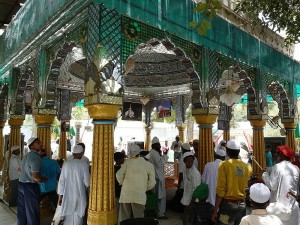 Sufism in India today is strongly linked to Imam Ahmed Raza Khan. In a way he was instrumental in the flourishing of Sufism and Sunnism. The Imam, who lived during the 14th century, tried to integrate orthodox Islamic values within the contemporary society. He explicated to his disciples such values as “the noble qualities of the beloved Prophet Muhammad, the permissibility or otherwise of the intercession of deceased ‘Saints’ (Pirs), or the correct manner of calling believers to the Mosque for the Friday congregational prayers.” Imam Raza’s notions of Prophet Muhammad’s role as mediator with Almighty Allah and his extraordinary achievements were congruent with Sufi concepts of spiritual authority and power (Sufism in India).
Sufism in India today is strongly linked to Imam Ahmed Raza Khan. In a way he was instrumental in the flourishing of Sufism and Sunnism. The Imam, who lived during the 14th century, tried to integrate orthodox Islamic values within the contemporary society. He explicated to his disciples such values as “the noble qualities of the beloved Prophet Muhammad, the permissibility or otherwise of the intercession of deceased ‘Saints’ (Pirs), or the correct manner of calling believers to the Mosque for the Friday congregational prayers.” Imam Raza’s notions of Prophet Muhammad’s role as mediator with Almighty Allah and his extraordinary achievements were congruent with Sufi concepts of spiritual authority and power (Sufism in India).
The Sufi sect in the Indian subcontinent started out as a spiritual exercise based on “intuition, esoteric knowledge and experience of the mystical world”. Hence, the trend of intellectualizing religious principles, which found expression early in the millennium, was in opposition to this fledgling religious sect. At the time of its ascendancy in India, the Suhrawardi’ leaders played a preeminent role in mitigating the power held by the ruling classes of the day. In effect, the Suhrawardi leaders took Islam toward a fundamentalist path. Nevertheless, “the large number of eminent Sufis whose vision of Islamic spiritual life was broadly based gave moral courage to the people by awakening in them spiritual values and reliance on God during calamities such as drought, floods, and panic due to protracted wars and foreign invasions” (Behera, 2002).
Much of the early traditions of Sufism are still evident in India today. The most widespread of it is Sufi poetry, once considered “an expression of the mystic love of thirsty soul seeking an intuitive understanding of God” (Behera, 2002). It has now evolved into an avenue for giving vent to spiritual feelings, which was prohibited erstwhile in the orthodox interpretation of Islam. In India, Sufi poetry is also related to Hindi (the predominant language in the northern Indian landscape). By incorporating elements of both these languages, the Sufi poetry that is in existence today opens up to its practitioners new ways of spiritual expression, one which is more liberal and artistic. Considering the fact that the Sufi poets of yesteryears concurred with the torchbearers of the Bhakti movement of Hinduism, the Sufi poetry of today contains in it traces of the Bhakti movement as well. The leaders of these movements questioned the rigid formalism of their respective religions and openly rebelled against misinterpretations and meaningless rituals. In a way, these two religious movements brought the spiritual aspects of Islam and Hindusim to the fore (Eaton, 1974). An important factor in the growth of these religious movements alongside the rise in Sufi poetry is the royal patronage enjoyed by them. For example,
“The devotion of some of the rulers and members of the governing classes to the Sufis went a long way toward making possible the erection of such masterpieces of architecture as the tomb of the Suhrawardī Shaykh Rukn al-Dīn in Multan, the khanqah of Mir Sayyid ‘Alī Hamadānī in Srinagar (Kashmir), and the tombs of Shaykh Muhòammad Ghawth in Gwalior and Shaykh Salīm Chishtī at Fatehpur Sikri. Eve the Mughal miniatures did not neglect the Sufi landscape; some of them integrate Sufi themes with the bhaktas (Hindu devotees)… But due to the support of members of various royal families, genuine Sufism survived this and other threats and has managed to stay alive in India to this day.” (Behera, 2002)
In the Indian subcontinent, the term ‘Wahhabi’ has come to represent a group of Muslims known as the Barelvis as well as other defendants of the Sufi saints. The Barelvis, the disciples of Ahmad Reza Khan, comprise an important minority among Sunni Muslims in India who follow similar rituals and beliefs although don’t identity themselves orthodox Muslims. Another group Deobandis, in addition to the Barelvis forms the core of Sufi adherents in northern India. The Barelvis and Deobandis are a dominant class of Indian society that their affiliation with Sufism has induced lasting changes to the Indian theological scene. Even to this day, the shrines of Sufi saints attract thousands of followers from different religious backgrounds (not just Muslims) as well as socio-economic backgrounds. Nevertheless, this phenomenon is not without controversy in contemporary India, where the leaders of orthodox Muslim sects brand this concept of polytheism un-Islamic. Some even go to the extent of questioning the Sufi practices. For example, some of the opponents to Sufism declare that since the Sufi saints were all long gone, the cult’s practices don’t hold any meaning. They further argue that some of the practices of Sufis (including building of tombs and monuments) is un-Islamic and blasphemous. Some of the protests have even threatened to turn into violent proportions (Ernst, 2005).
The rich heritage of Sufism in India is inseparable with the rise of Islam in the Indian subcontinent. While there was much opposition to the liberal and sensual elements of the Sufi sect, it has to be remembered that without Sufism’s strong base, the Indian subcontinent would not have seen the growth of Islam as it is today. For example,